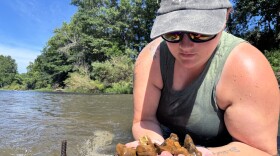-
KBIA’s The Next Harvest podcast tells the stories of farmers in the Midwest using regenerative agriculture practices and high-tech tools to make their farms sustainable -- including agrivoltaics, drones, precision agriculture, and cover crops.
-
At grassland sites worldwide, including the Midwest and Great Plains, scientists simulated extreme drought conditions. The study provides a far-reaching and systematic look at the effects of drought severity.
-
The fish and rare mussels hiding in the Spring River that flows through Kansas and Missouri are signs that environmental cleanups are helping river wildlife recover from a century of mining pollution.
-
Deep Fission says it plans to install a nuclear reactor underground at an industrial park in southeast Kansas. State and local government leaders are on board. It’s part of a national push for new nuclear energy generation.
-
Some of the country's highest home insurance prices are in the central U.S., a region generally considered to be protected from climate-driven disasters such as wildfires and hurricanes.
-
Tech companies have been building more data centers around Kansas City, spurred by the increased need for artificial intelligence. But residents are worried about the environmental impact, higher utility bills, and the long-term consequences for communities.
-
Monarch butterflies usually flutter into Kansas City in swarms and visit for a couple of days before continuing south to Mexico. But with prolonged summer heat and heavy winds, the monarchs’ migration trickled through over weeks.
-
Two companies are pursuing two very different visions for building and operating nuclear reactors in Kansas.
-
Deep Fission is a fledgling startup that says it can help tech companies meet the "explosive demand" for more energy to power artificial intelligence. It's one of two nuclear companies that have announced plans related to Kansas in the past month.
-
Dr. Imogen Herrick, assistant professor of STEM Education at the University of Kansas, is changing the way climate change is discussed in K-12 classrooms. Her Community Science Data Talks shift the focus from global issues and intangible statistics to local impacts and student emotions.
-
A company cofounded by Bill Gates will explore building a reactor in Kansas. It would generate power without emissions, but environmental groups have concerns.
-
Leaves typically start to peak in the Kansas City region by early October, but projecting peak foliage isn't an exact science. Here are some things you can do to get the most out of fall's colors.
Play Live Radio
Next Up:
0:00
0:00
Available On Air Stations











